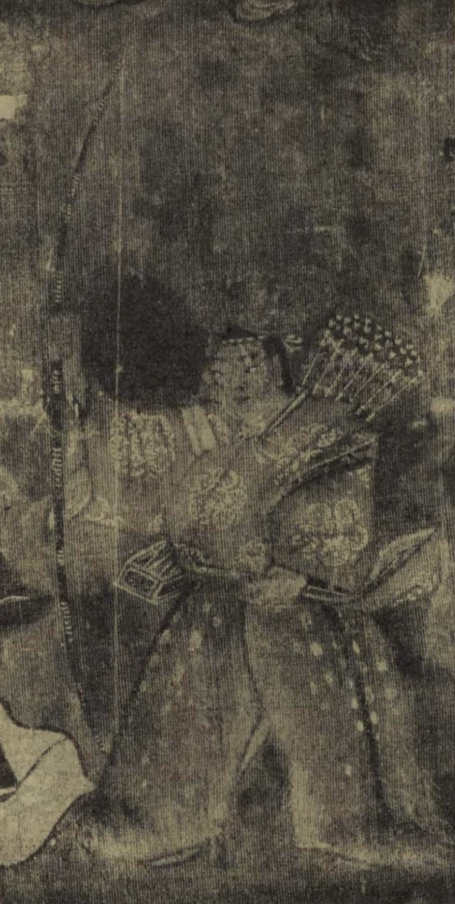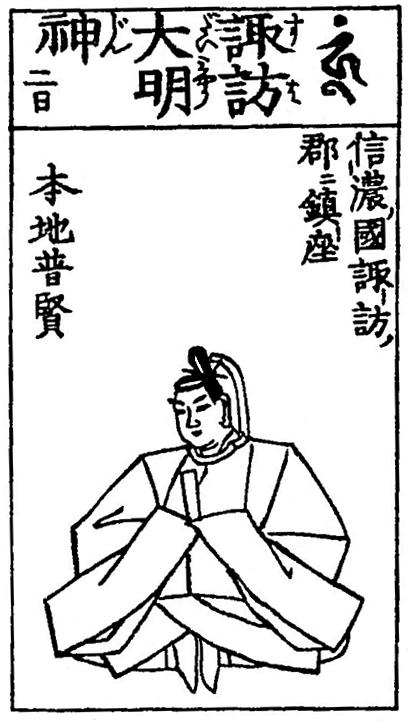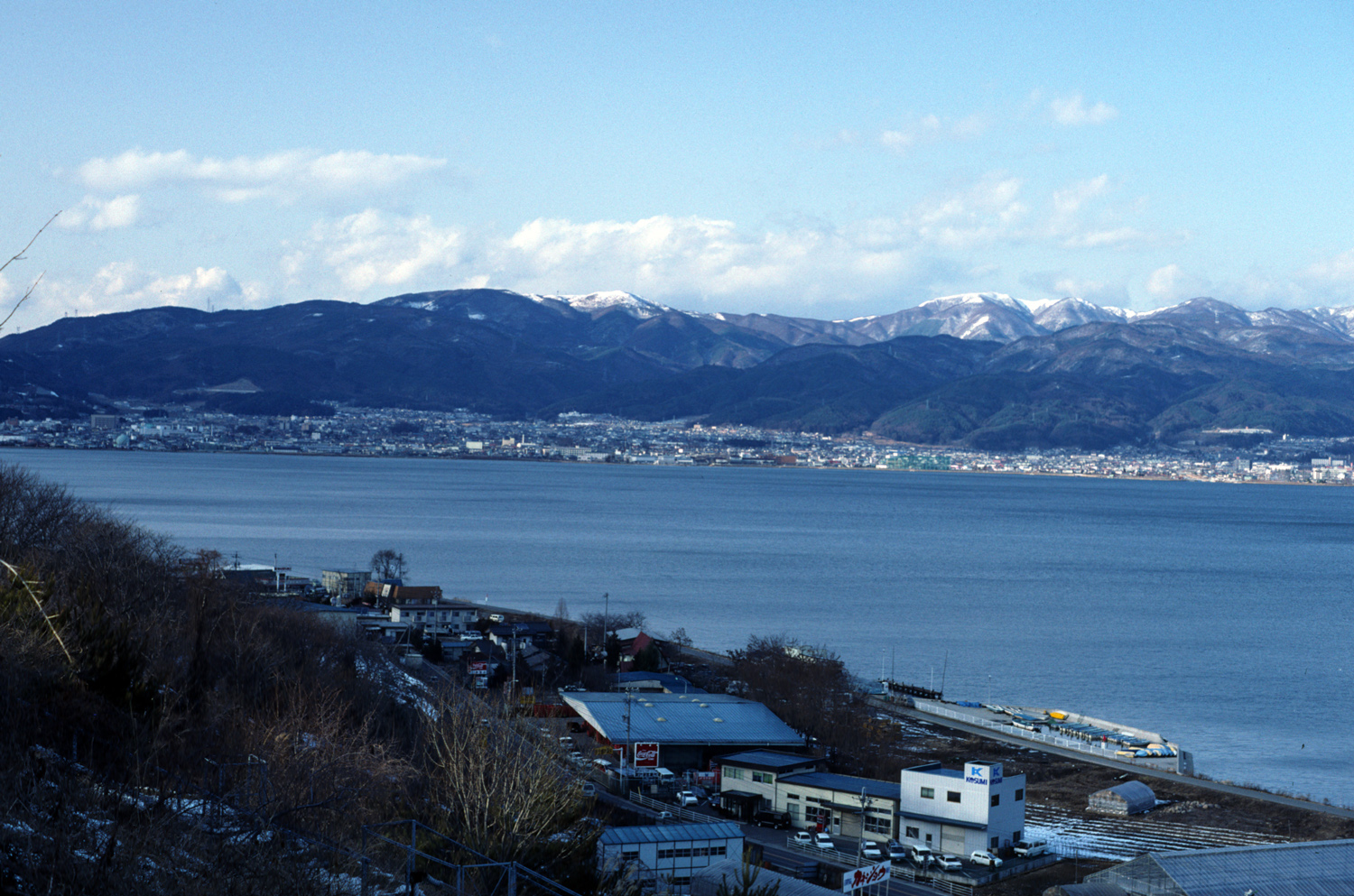|
Moreya
Moreya or Moriya (洩矢神, ''Moriya- / Moreya-no-Kami'') is a Japanese god who appears in various myths and legends of the Suwa region in Nagano Prefecture (historical Shinano Province). The most famous of such stories is that of his battle against Takeminakata, the god of the Grand Shrine of Suwa (''Suwa Taisha''). Moriya is regarded as the mythical ancestor of the Moriya clan (守矢氏), a priestly family that formerly served in the Upper Suwa Shrine (上社, ''Kamisha''), one of the two sub-shrines that make up Suwa Taisha. In addition, he is venerated as a local tutelary deity (''ubusunagami'') in a shrine in Okaya City near the Tenryū River, which in later variants of the aforementioned myth is identified as the place where Takeminakata and Moriya fought each other. Local historians have long interpreted the story of the conflict between the two deities as the mythicization of a historical event in which a powerful local clan that ruled the Lake Suwa region and its ... [...More Info...] [...Related Items...] OR: [Wikipedia] [Google] [Baidu] |
Suwa Taisha
, historically also known as Suwa Shrine (諏訪神社 ''Suwa-jinja'') or , is a group of Shinto shrines in Nagano Prefecture, Japan. The shrine complex is the ''ichinomiya'' of former Shinano Province and is considered to be one of the oldest shrines in existence, being implied by the '' Nihon Shoki'' to already stand in the late 7th century. Kanpei-taisha Overview The entire Suwa shrine complex consists of four main shrines grouped into two sites: the Upper Shrine or ''Kamisha'' (上社), comprising the and the , and the Lower Shrine or ''Shimosha'' (下社), comprising the ''Harumiya'' (春宮, spring shrine) and the ''Akimiya'' (秋宮, autumn shrine). The Upper Shrine is located on the south side of Lake Suwa, in the cities of Chino and Suwa, while the Lower Shrine is on the northern side of the lake, in the town of Shimosuwa. In addition to these four main shrines, some sixty other auxiliary shrines scattered throughout the Lake Suwa area (ranging from miniature sto ... [...More Info...] [...Related Items...] OR: [Wikipedia] [Google] [Baidu] |
Takeminakata
Takeminakata (タケミナカタ), also known as Minakatatomi or Takeminakatatomi, is a ''kami'' in Japanese mythology. Also known as or after Suwa Grand Shrine (Suwa Taisha) in Nagano Prefecture (former Shinano Province) in which he is enshrined alongside his consort Yasakatome, Takeminakata is historically worshiped as a god of wind, water and agriculture, as well as a patron of hunting and warfare, in which capacity he enjoyed a particularly fervent cult from various samurai clans during the medieval period such as the Hōjō or the Takeda. Takeminakata was also held to be the mythical ancestor of certain families who once served at the shrine as priests, foremost among them being the Suwa clan, the high priests of the Upper Shrine of Suwa who were also revered as living vessels of the god. Whereas in the ''Kojiki'' (ca. 712 CE) and later derivative accounts, Takeminakata appears as one of the sons of the god Ōkuninushi who fled to Lake Suwa after being defeated by the ... [...More Info...] [...Related Items...] OR: [Wikipedia] [Google] [Baidu] |
Mishaguji
, also known as Misakuji(n), Mis(h)aguchi or Mishakuji among other variants (see below), is a deity or spirit, or several, that featured in certain religious rites formerly practiced in the Upper Shrine of Suwa, one of the two shrines that comprise the Suwa Grand Shrine complex in Nagano Prefecture (historical Shinano Province). In such ceremonies, the Mishaguji were 'summoned' by one of the shrine's high-ranking priests, the ''Kan-no-Osa'' (神長, also ''Jinchō'') or ''Jinchōkan'' (神長官), into persons or objects that would act as their vessels (''yorishiro'') for the duration of the ritual, being then 'dismissed' upon its completion. In addition to playing a role in Suwa Shrine's religious rites, the Mishaguji are also enshrined in 'Mishaguji Shrines' (御社宮司社 ''Mishaguji-sha'') found throughout the Lake Suwa region and its vicinity. Worship of ''kami'' with similar-sounding names are also attested in various localities throughout east and central Japan; ind ... [...More Info...] [...Related Items...] OR: [Wikipedia] [Google] [Baidu] |
Suwa Clan
The , also known as the Jin or Miwa clan (神氏, ''Miwa uji / Miwa-shi'' or ''Jinshi'') was a Japanese '' shake'' and samurai family. Originating from the area encompassing Lake Suwa in Shinano Province (modern-day Nagano Prefecture), it was originally a family of priests who served at the Upper Shrine of Suwa located on the southwestern side of the lake. By the Kamakura period, it thrived as a prominent samurai clan with close ties to the shogunate. Surviving the fall of both the Kamakura shogunate and the Southern Imperial Court which it supported, its feud with local rival clans, and frequent clashes with its neighbor in Kai, the Takeda clan, during the Sengoku period (which ended in the extinction of the main family), by the Edo period the clan had split into two branches: one ruling the Suwa Domain of Shinano as '' daimyō'', with the other continuing to serve as priests of Suwa Shrine until the Meiji period. Ancestry In legend Although the Suwa, which was th ... [...More Info...] [...Related Items...] OR: [Wikipedia] [Google] [Baidu] |
Suwa Daimyōjin Ekotoba
The ''Suwa Daimyōjin Ekotoba'' (諏方大明神画詞 or 諏訪大明神絵詞 "Illustrated Record of Suwa Daimyōjin (Shrine)"), also known as ''Suwa Daimyōjin Go-engi Shidai'' (諏訪大明神御縁起次第 "Order of Legends (''Engi'') of Suwa Daimyōjin (Shrine)") or ''Suwa(-sha) Engi Emaki'' (諏方(社)縁起絵巻 "Illustrated Legends of Suwa (Shrine)"), was a twelve (originally ten) volume set of ''emakimono'' or painted handscrolls completed in 1356 (Enbun 1),Suwa Shishi Hensan Iinkai, ed. (1995). p. 814. during the Nanboku-chō period. Originally describing and depicting legends concerning the Suwa Grand Shrine in Shinano Province (modern-day Nagano Prefecture) and its deity as well as its various religious festivals as performed during the Middle Ages, the original scrolls containing the illustrations were eventually lost, with only the text being preserved in various manuscripts. Historical overview The ''Ekotoba'' was created under the supervision of Suwa (or ... [...More Info...] [...Related Items...] OR: [Wikipedia] [Google] [Baidu] |
Okaya, Nagano
is a city located in Nagano Prefecture, Japan. , the city had an estimated population of 48,616 in 19,257 households, and a population density of 570 persons per km². The total area of the city is . Geography Okaya is located in central Nagano Prefecture at the western shores of Lake Suwa and the headwaters of the Tenryū River. Surrounding municipalities *Nagano Prefecture ** Matsumoto ** Shiojiri ** Suwa ** Shimosuwa ** Tatsuno Climate The city has a climate characterized by characterized by hot and humid summers, and relatively mild winters ( Köppen climate classification ''Cfa''). The average annual temperature in Okaya is 10.6 °C. The average annual rainfall is 1281 mm with September as the wettest month. The temperatures are highest on average in August, at around 23.6 °C, and lowest in January, at around -1.9 °C. Demographics Per Japanese census data, the population of Okaya has declined over the past 50 years. History The area of ... [...More Info...] [...Related Items...] OR: [Wikipedia] [Google] [Baidu] |
Chino, Nagano
is a city located in Nagano Prefecture, Japan. , the city had an estimated population of 55,673 in 23,236 households, and a population density of 210 persons per km². The total area of the city is . Geography Chino is located in a mountainous area of the east-central Nagano prefecture. Notable mountains within the city limits include Mount Yatsugatake, Mount Tateshina, and Mount Kirigamine. Chino city hall is located at an elevation of 801 meters and is thus the highest city hall location in Japan. Climate The city has a climate characterized by hot and humid summers, and relatively mild winters (Köppen climate classification ''Cfa''). The average annual temperature in Chino is 10.9 °C. The average annual rainfall is 1310 mm with September as the wettest month. The temperatures are highest on average in August, at around 23.6 °C, and lowest in January, at around -1.8 °C. The mountainous portions of the city are considered part of the snow country ... [...More Info...] [...Related Items...] OR: [Wikipedia] [Google] [Baidu] |
Meiji Period
The is an era of Japanese history that extended from October 23, 1868 to July 30, 1912. The Meiji era was the first half of the Empire of Japan, when the Japanese people moved from being an isolated feudal society at risk of colonization by Western powers to the new paradigm of a modern, industrialized nation state and emergent great power, influenced by Western scientific, technological, philosophical, political, legal, and aesthetic ideas. As a result of such wholesale adoption of radically different ideas, the changes to Japan were profound, and affected its social structure, internal politics, economy, military, and foreign relations. The period corresponded to the reign of Emperor Meiji. It was preceded by the Keiō era and was succeeded by the Taishō era, upon the accession of Emperor Taishō. The rapid modernization during the Meiji era was not without its opponents, as the rapid changes to society caused many disaffected traditionalists from the former samurai ... [...More Info...] [...Related Items...] OR: [Wikipedia] [Google] [Baidu] |
State Shinto
was Imperial Japan's ideological use of the Japanese folk religion and traditions of Shinto. The state exercised control of shrine finances and training regimes for priests to strongly encourage Shinto practices that emphasized the Emperor as a divine being. The State Shinto ideology emerged at the start of the Meiji era, after government officials defined freedom of religion within the Meiji Constitution. Imperial scholars believed Shinto reflected the historical fact of the Emperor's divine origins rather than a religious belief, and argued that it should enjoy a privileged relationship with the Japanese state. The government argued that Shinto was a non-religious moral tradition and patriotic practice, to give the impression that they supported religious freedom. Though early Meiji-era attempts to unite Shinto and the state failed, this non-religious concept of ideological Shinto was incorporated into state bureaucracy. Shrines were defined as patriotic, not religious, i ... [...More Info...] [...Related Items...] OR: [Wikipedia] [Google] [Baidu] |
Shimosuwa
is a town located in Nagano Prefecture, Japan. , the town had an estimated population of 20,055 in 8864 households, and a population density of 300 persons per km². The total area of the town is . Geography Shimosuwa is located in central Nagano Prefecture, approximately 50 kilometers from the prefectural capital of Nagano city and 200 kilometers from Tokyo. The town is bordered on the south by Lake Suwa. The town has an altitude of 760 meters at the town center, and is 82% forested. Surrounding municipalities *Nagano Prefecture ** Matsumoto ** Suwa ** Okaya ** Nagawa Climate The town has a humid continental climate characterized by warm and humid summers, and cold winters (Köppen climate classification ''Dfb''). The average annual temperature in Shimosuwa is 7.3 °C. The average annual rainfall is 1540 mm with September as the wettest month. The temperatures are highest on average in August, at around 20.2 °C, and lowest in January, at around -5.1 ... [...More Info...] [...Related Items...] OR: [Wikipedia] [Google] [Baidu] |
Mononobe No Moriya
was an '' Ō-muraji'', a high-ranking clan head position of the ancient Japanese Yamato state, having inherited the position from his father Mononobe no Okoshi. Like his father, he was a devoted opponent of Buddhism, which had recently been introduced to Japan from the continent. Alongside Nakatomi no Katsumi, Moriya worked to counteract the efforts of Soga no Umako, another high-ranking noble who supported the adoption of Buddhism. Though Mononobe and Nakatomi saw brief success under the reign of Emperor Bidatsu (572-585), his successor, Emperor Yōmei, became Buddhist and so Mononobe's fortunes turned. Following the death of Emperor Yōmei in 587, Mononobe's party and Soga's each sought to influence the succession. The dispute quickly erupted into outright battle, in which Mononobe no Moriya is credited with setting fire to the first Buddhist temples in Japan, and tossing the first images of the Buddha, imported from Baekje, into the canals of the city of Naniwa (now Osaka ... [...More Info...] [...Related Items...] OR: [Wikipedia] [Google] [Baidu] |








